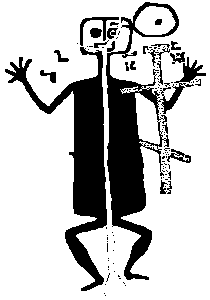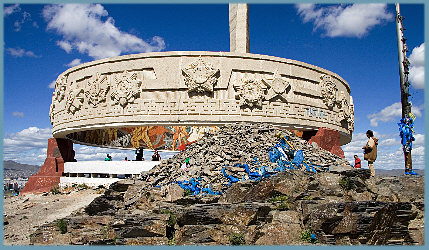Kärt Summatavet
Key words: fine arts, folk art, fieldwork, professional art education
The article explores the problems which emerged in professional art education during the 20th century in order to explain the reasons for the unpopularity of artistic creation dealing with local visual identity in Estonia in the last decade of the century. The article also investigates the activities of artists who worked at interpreting and collecting tangible heritage at the beginning of the 20th century. The application of empirical experience and artistic categories in linking folk art and professional art is examined in the folklore-related creative and pedagogical work of Kristjan Raud. The methods and goals of interpreting folklore that dominated professional art education at the beginning of and in the second half of the 20th century are compared. The possibilities of fieldwork methods available for examining the repertoires of the authors of artefacts in traditional communities and for their use in the search for sources of inspiration are explained.
While in the last few years, elements of ethnology and folklore have experienced a rising trend in the world’s high fashion, design and contemporary arts, Estonia has devoted little attention to its own traditions in the 21st century. The deeper roots of the problem lie in the limited understanding of culture and history among the younger generation and the lukewarm interest of art politicians in artistic creation that deals with the local identity. Estonian artists working at the beginning of the 20th century were transmitters of tradition and had more direct ties to folklore as a source of inspiration. Kristjan Raud encouraged his young colleagues and art students to participate in the collection of folklore and traditional objects in villages and most of the prominent artists of that period made at least one fieldtrip to collect tangible heritage for the Estonian National Museum.
Raud emphasized that the artefacts decorated with the patterns of previous generations were inspired by profound ideas and were not arranged randomly. He was convinced that the previous generations expressed in their creative work old spiritual values, profound feelings and the experience of everyday life, they had great artistic talent; Raud also pointed out the educational, developmental and artistically directing influence of tangible heritage.
Artefacts symbolise a certain skill of thinking and writing in oral culture, a visible expression of the ethnic language and mentality. Fieldwork provides an artist an opportunity to examine the practical needs of the authors of tangible heritage, and in addition to preferences in taste, to also get a better view of the mindset, traditional environment, the existing norms and creative practices of the transmitters of tradition. Texts presented in visual form “speak” in a coded language, which is acceptable in the community, and reflect the creative process of the members of the community who have created the artefacts as a composite system. On the one hand, the messages these artefacts convey are regulated by standards that are shared by the community and mutually agreed upon, while on the other hand they convey autobiographical visual narratives of the producer. The important factor here is the relating of professional art education, creation, and fieldwork to issues of the unexplored authorship of Estonian tangible culture and the context of creative self-expression practices.

Enn Ernits
Key words: rock art, Karelia, devil, legends, Christianity
The article discusses the link between rock-carvings of Lake Onega in one of their locations, Cape Besov Nos, and five legends about devils. These are mostly new interpretations of etiological legends. The stories describe the origin of a rock island near the cape and the birth of some petroglyphs (the giant anthropomorphic figure of Cape Besov Nos, and representations resembling sun and staff). The legends discuss the devils’ conflict with Christianity, their flight and perdition. One legend contains the motif of how the devil may crawl into a vessel if it does not have a lid or a cross-sign made on it. The weakening of the association of the local population with petroglyphs and the influence of Christianity led to the identification of the giant anthropomorphic figure with devil and the belief that smaller figures were made by devils. The motif of a devil in a kvass vessel seems to share common elements with the hagiography of the first bishop of Novgorod (12th century), which was probably known also in the areas beyond Lake Onega. The article attempts to refute the chrestomatic view that the cross-sign on the anthropomorphic figure and a swan representation at Cape Besov Nos has been carved by monks of the Saviour Monastery of Murom in the 14th century or later, because the Besov village remained outside the sphere of influence of the said monastery. It is more likely that it was carved in the 16th century or later by the clergy of Shala and Nigizhma.
Jinseok Seo
Key words: chonsol (legend), Korea, Korean oral folklore, mindam (folktale), legend hero, Shamanism, shinhua (myth)
The article discusses the structure of Korean legends as representative of female heroism, the purpose of which was to instil courage and hope in women at the time, and thereby proves that Korean legends are not merely a passive reflection of the social situation but serve an active function of influencing the society in a particular way and arranging the illogical social organisation. In addition, the article studies the heroism of Korean women in legends glorifying their beauty and dignity. In Korean legends, women are mostly perceived as passive mediators whose function is to give birth to heroes. But there are also other legends, which have been passed on throughout the long history, the nature and structure of which is analogous to European legends. Perhaps there have been other such legends, but they have not been preserved owing to the fact that the Korean society has been long dominated by men or nobility.
The myths and legends are not merely simple representations of Korean society at the time, but serve as antisocial messages by shamans of the lowest social stratum, who lived under double pressure. Their message was that all people are born equal and share equal human rights, and they ridiculed the hypocrisy of the nobility, who harshly criticised shamans but eventually followed their advice.
Anneli Baran
Key words: intensive phrases, hyperbole, metonymy, conceptualisation, metonymic hierarchies
The database of Estonian phrases contains numerous hyperbolic phrases such as üldse mitte ‘not at all’, mitte kõige vähimatki ‘not in the least’, mitte vähimalgi määral ‘not one bit’. These phrases are mostly expressions of negation, and could be more specifically referred to as negation intensive phrases. In these phrases, hyperbole is mostly concerned with caricaturelike exaggeration of ignorance, indolence, or any other human vice. Such exaggeration may often lead to the grotesque or absurd. This paper investigates the use of hyperbole as a stylistic device in more detail.
Guldzhahon Jussufi
Key words: folk song, psaltery, accordion, musical creation, popular repertoire
Popular music, even though it can still be heard here and there in more casual atmosphere, has found itself in a bind. The aggressive flow of modern music has pushed the more modest tunes aside. People no longer sing along together to some traditional accompanied tune. A performance of popular music requires men with guitars, drums and sound systems, and the rest of the group no longer actively participate in music, but form an audience who is performed to. Nevertheless, ethnic identity is still very much constructed through the musical tradition of previous generations.
Shifts in musical preferences or popular repertoire, or the disappearance of the repertoire from active use are caused by the pressure of music trends rather than by the internal development of music. The repertoire of instrumental music is enjoying a stable period and the recordings contributed to the archives suggest that this has been the case for a long time. The more popular tales date back to the pre-war period, and during the Soviet period instrumental musicians appear to be absent altogether.
Even though popular repertoire does not expand with new pieces, instrumental music is not completely stagnated. The more talented musicians have different ways of sensing the music: in their interpretation the popular song alternates, varies, but sometimes emerges as a new song which resembles the old one only by the title.
Older folk tune has recently enjoyed considerable success. It is learned and performed but mostly tends to serve as a crowd puller at summer music events. It is indeed difficult to imagine that a lost art could be revived into active existence. It would be far more advantageous to preserve and promote what still has massive influence: popular song and instrumental music. Time will tell whether anyone other than singers and musicians themselves will consider it a value to hold on to.

The first part of Aado Lintrop’s travelogue from a visit to the conference on ancient Mongolian religion in Mongolia.
Ekaterina Anastasova, senior research associate at the Institute of Folklore Studies, Bulgarian Academy of Sciences, is interviewed by Mare Kõiva.
News, overviews
On May 23, 2007, Rein Saukas, expert of minor forms of folklore and editor at the Dept. of Folkloristics, Estonian Literary Museum, celebrated his 60th birthday. Overview of Rein Saukas’ life and career by Piret Voolaid.
The International Colloquium: Ethnomedicine and Ethnobotany within Cultural Context and Everyday Life was held on March 23–24, 2007 at Koke guesthouse in South Estonia. Lengthier overview of the event by Piret Paal is available in English in vol. 36 of Folklore: Electronic Journal of Folklore (http://www.folklore.ee/folklore/vol36/news.pdf).
On May 4, 2007, the international seminar Holy Groves around the Baltic Sea was organised by the Department of Folkloristics at the Estonian Literary Museum, the Centre of Cultural History and Folkloristics in Estonia, and the Chair of Archaeology, University of Tartu. Lengthier overview of the event by Kaisa Sammelselg is available in English in vol. 37 of Folklore: Electronic Journal of Folklore (http://www.folklore.ee/folklore/vol37/news.pdf).
Eda Kalmre. Hirm ja võõraviha sõjajärgses Tartus. Pärimuslooline uurimus kannibalistlikest kuulujuttudest. (Fear and hatred of the ‘other’ in post-war Tartu. A folkloristic study of cannibalistic rumours). Tänapäevafolkloorist/Contemporary Folklore. Tartu: EKM Teaduskirjastus 2007, 239 pp. Review of the book, based on Eda Kalmre’s PhD thesis, by Mare Kõiva. The review is available in English in vol. 37 of Folklore: Electronic Journal of Folklore (http://www.folklore.ee/folklore/vol37/news.pdf).
Екатерина Анастасова. Етничност, традиция,
власт. Етюди за прехода. София: Академично
издателство Марин Дринов. [Ekaterina Anastasova. Ethnicity, Tradition, and Power. Essays on tradition. Marin Drinov Academic Publishing House] Sofia. 2006. 148 pp. Review by Galina Ponomareva. The review is available in English in vol. 37 of Folklore: Electronic Journal of Folklore (http://www.folklore.ee/folklore/vol37/books.pdf).
Spiritual Folk Singing. Nordic and Baltic Protestant Traditions. Kristen Sass Bak, Svend Nielsen (eds.). Denmark, Forlaget Kragen. 2006. 284 pp. Review by Helen Kõmmus. The review is available in English in vol. 36 of Folklore: Electronic Journal of Folklore (http://www.folklore.ee/folklore/vol36/books.pdf).
Fingerroos, Outi & Haanpää, Riina & Heimo, Anne & Peltonen, Ulla-Maija (eds.). 2006. Muistitietotutkimus. Metodologisia kysymyksiä. Tietolipas 214. Helsinki: Suomalaisen Kirjallisuuden Seura. 304 pp. Review of the book by Tiiu Jaago.
Е. Г. Дэвлет & М. А. Дэвлет. Мифы в камне. Мир наскального искусства России. Myths in Stone. World of Rock Art in Russia. Москва: Алетейа. 2005. 472 pp, illustrations and 96 pp. of colour photographs. Review of the Davlets’ book by Enn Ernits.